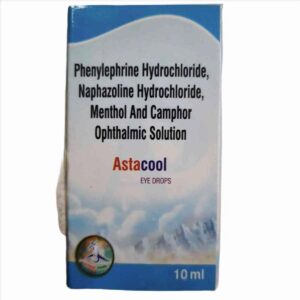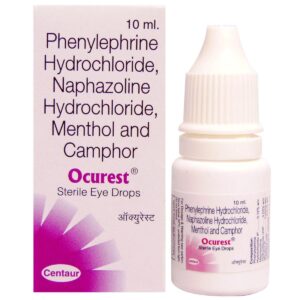MENTHOL + NAPHAZOLINE + PHENYLEPHRINE + CAMPHOR
Menthol: Menthol is a natural compound derived from the leaves of the peppermint plant (Mentha piperita). It is widely used in various pharmaceutical, cosmetic, and personal care products due to its refreshing and cooling sensation.
Menthol has multiple uses, including topical analgesic and antipruritic (anti-itch) properties. It is commonly found in over-the-counter products such as chest rubs, nasal inhalers, lozenges, and creams. It is used to relieve minor muscle aches, sprains, inflammation, and itching associated with insect bites and skin irritations.
The exact mechanism of action of menthol is not fully understood but is believed to involve the activation of cold-sensitive receptors known as TRPM8 receptors in the skin and mucous membranes. This activation leads to a cooling sensation and a mild analgesic effect. Menthol is also thought to have local anesthetic properties and can interact with other receptors involved in pain perception.
The dose of menthol can vary depending on the product and its intended use. In most topical products, the menthol concentration ranges from 0.1% to 1%. It is important to follow the instructions provided on the specific product packaging for proper application and dosage.
Menthol is generally considered safe when used as directed. However, some individuals may experience side effects, which are usually mild and temporary. Common side effects include skin irritation, stinging, or burning at the site of application. In rare cases, individuals may experience an allergic reaction, characterized by rash, itching, or swelling. If any severe or persistent side effects occur, it is advisable to discontinue use and seek medical attention.
It is worth noting that menthol should not be used on broken or damaged skin, and caution should be exercised when using products containing menthol around the eyes, nose, and mouth. Menthol should also be used with care in children, pregnant women, and individuals with known sensitivities or allergies to menthol.
Overall, menthol is a widely used compound known for its cooling and soothing effects. It provides temporary relief from minor muscular discomfort and itchiness and is available in various forms to cater to different needs.
Naphazoline: Naphazoline is a medication that belongs to the group of drugs called sympathomimetic agents. It is commonly used as a component in various over-the-counter eye drops and nasal sprays.
Naphazoline works by constricting the blood vessels in the eyes, which helps to relieve symptoms such as redness, itching, and watering caused by allergies or irritation. When used in nasal sprays, it helps to shrink swollen blood vessels in the nasal passages and reduce nasal congestion.
The recommended dose of naphazoline depends on the specific product and the condition being treated. Typically, one to two drops or sprays are applied to the affected eye(s) or nostril(s) as directed by the package instructions or as prescribed by a healthcare professional. The frequency of use may vary, but it is generally recommended to use it no more than a few times a day and for a limited duration.
As with any medication, naphazoline may cause unwanted side effects. Common side effects include stinging or burning sensation, temporary blurred vision, headache, dryness or irritation of the eyes or nasal passages. These side effects are usually mild and go away on their own. However, if they persist or become severe, it is advisable to consult a healthcare professional.
It is important to note that prolonged or excessive use of naphazoline can have adverse effects, such as rebound congestion or worsening of symptoms. It is recommended to follow the instructions provided and not exceed the recommended dose or duration of use.
In some cases, naphazoline may not be suitable for individuals with certain medical conditions, such as glaucoma, high blood pressure, or an enlarged prostate. It is important to consult a healthcare professional or pharmacist before using naphazoline to ensure it is safe and appropriate for you.
Phenylephrine: Phenylephrine is a medication used primarily as a nasal decongestant and to treat symptoms of allergies and sinusitis. It belongs to the class of drugs called sympathomimetic agents, specifically alpha-adrenergic agonists.
The primary mechanism of action of phenylephrine is the stimulation of alpha-1 adrenergic receptors in the blood vessels, particularly those in the nasal passages. This stimulation causes vasoconstriction, leading to a decrease in the swelling and congestion in the nasal mucosa, thus providing relief from nasal congestion and promoting easier breathing. As a result, it can alleviate symptoms associated with common cold, hay fever, allergies, and sinusitis.
Phenylephrine is commonly available in nasal sprays, drops, and oral formulations. The dosage and administration may vary depending on the specific product and indication. It is important to follow the instructions provided by the healthcare professional or as directed on the medication package.
While generally considered safe, phenylephrine may cause some side effects. Common side effects include temporary burning, stinging, or dryness of the nose or throat, sneezing, dizziness, headache, nervousness, and increased blood pressure. These side effects are usually mild and temporary.
In rare cases, phenylephrine can lead to more severe side effects, such as severe allergic reactions (rash, itching, swelling, severe dizziness, difficulty breathing), rapid or irregular heart rate, chest pain, anxiety, hallucinations, or difficulty urinating. If any of these serious side effects occur, it is important to seek immediate medical attention.
Phenylephrine should not be used in individuals with certain medical conditions, such as severe high blood pressure, heart disease, thyroid problems, or diabetes, without the consultation of a healthcare professional. Additionally, it is important to inform the healthcare provider about any other medications, supplements, or herbal products being taken, as they may interact with phenylephrine.
In summary, phenylephrine is a nasal decongestant commonly used to alleviate symptoms of nasal congestion due to allergies, sinusitis, and the common cold. It exerts its effects through alpha-1 adrenergic receptor stimulation leading to vasoconstriction. While generally safe, it may cause mild side effects, and serious side effects should be reported to a healthcare professional immediately.
Camphor: Camphor is a medication that has been used for many years due to its versatile properties. It is derived from the camphor tree and is available in the form of oil, cream, or gel.
Camphor has several uses. It is commonly used topically to relieve pain and itching associated with minor burns, insect bites, or skin irritation. It can also be found in cough and cold remedies, as it helps to alleviate congestion and cough symptoms. Additionally, camphor has been used in traditional medicine for its potential antifungal and antibacterial properties.
The mechanism of action of camphor is not fully understood, but it is believed to work by stimulating nerve endings, which produces a cooling and numbing effect on the skin. This helps to relieve pain and itching. When used in cough and cold remedies, camphor acts as a decongestant by clearing nasal passages and thinning mucus.
The dose of camphor depends on its form and strength. The topical cream or gel should be applied sparingly to the affected area and gently massaged into the skin. It is important to read and follow the instructions on the product label carefully. When using camphor for inhalation in cough and cold remedies, it is typically mixed with hot water and used as a steam inhalation. Again, it is crucial to follow the recommended dosage instructions provided.
While camphor is generally considered safe when used as directed, it may cause some side effects. Common side effects of topical use include skin irritation, redness, or rash. In rare cases, camphor ingestion or excessive topical application can lead to more severe side effects, such as nausea, vomiting, dizziness, confusion, seizures, or even liver damage. It is essential to avoid ingesting or using excessive amounts of camphor.
Camphor should not be used on broken or irritated skin, and it is generally not recommended for use in children under the age of two. Pregnant or breastfeeding women should consult their healthcare provider before using camphor products.
In summary, camphor is a topical medication used for pain relief, itching, and congestion relief. Its mechanism of action involves its ability to stimulate nerve endings and produce a cooling effect. It is important to follow the recommended dose and use caution to avoid potential side effects associated with excessive use.


